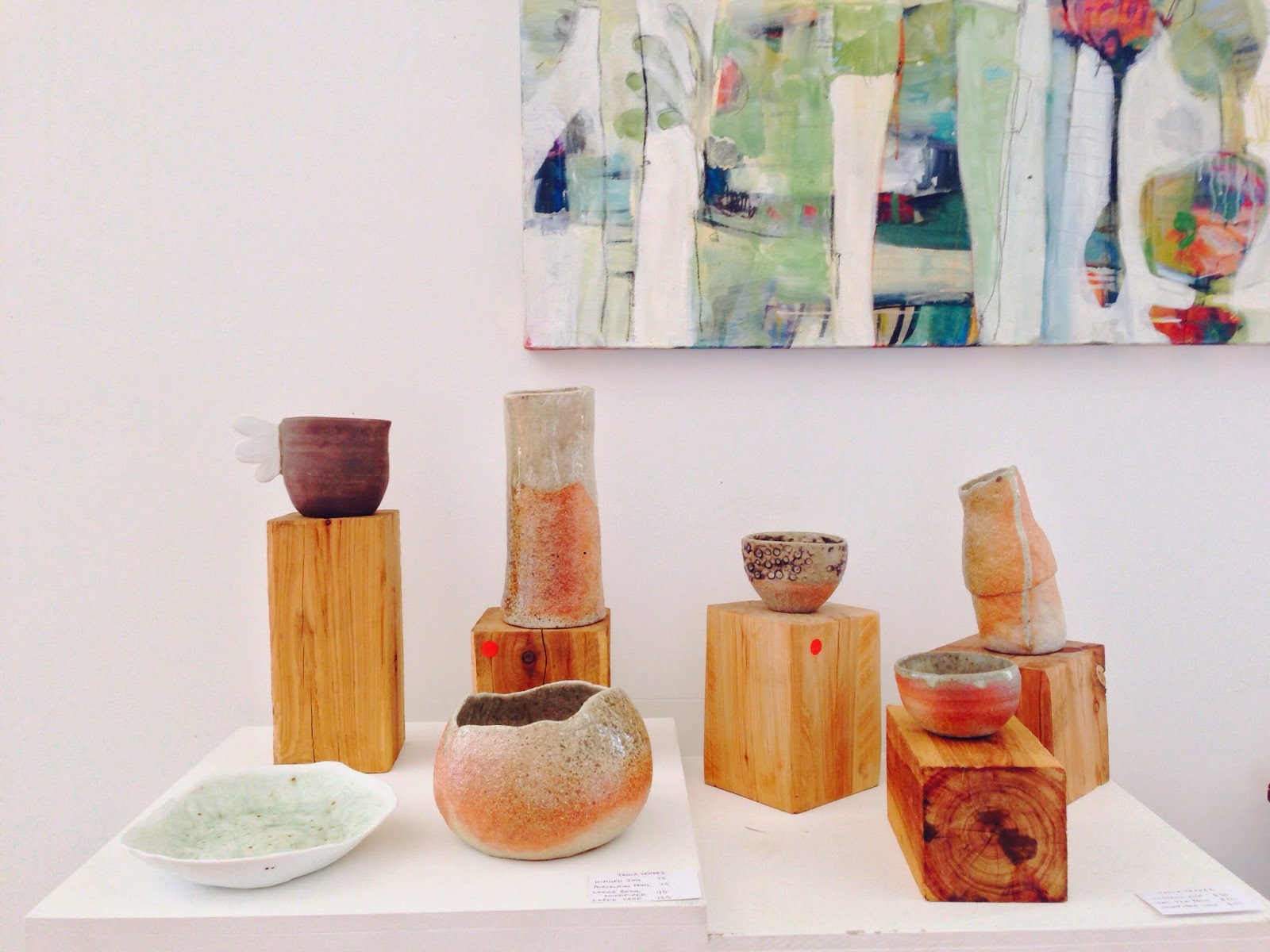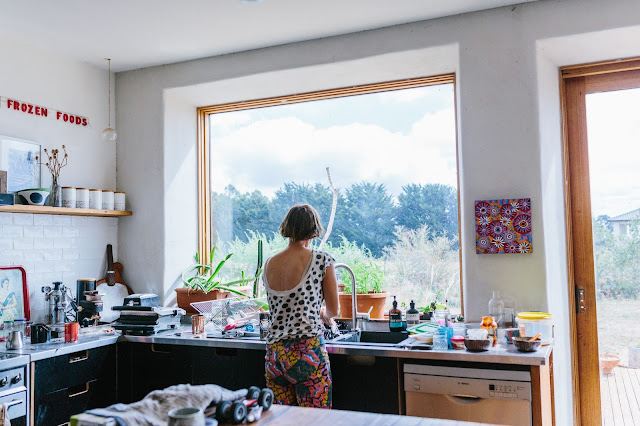Clayspace Daylesford Community Wood-firing
Over ANZAC weekend I had the great pleasure of being part of a community wood-firing here in Daylesford. To be included in such a wonderful group of potters (which included my amazing teacher, Minna Graham, the incredible Petrus Spronk, Kim Haughie Kath Wratten, Georgia Harvey) was really very special and I was just so excited about it. Having no idea about wood firing I knew it was an opportunity to learn a lot, by doing and by talking with the rest of the crew.
Wood, a lot of wood, we had cut and stacked prior to the firing weekend. On Friday, with great excitement, we met to pack the kiln and seal her up. This was a
chance to check out everyone's work and ask a never ending stream of questions.
We sorted the work by size and discussed some of the possible effects of kiln placement. The throat of the kiln which is closest to the fire, can create some dramatic and sometimes wonderful effects, but its also a dangerous spot, and the work may get broken. Its a sort of high risk, high payoff sort of scenario, not for the faint hearted, like me. Perhaps I'll be more adventurous next time round?
chance to check out everyone's work and ask a never ending stream of questions.
We sorted the work by size and discussed some of the possible effects of kiln placement. The throat of the kiln which is closest to the fire, can create some dramatic and sometimes wonderful effects, but its also a dangerous spot, and the work may get broken. Its a sort of high risk, high payoff sort of scenario, not for the faint hearted, like me. Perhaps I'll be more adventurous next time round?
Once the kiln was full, and looking beautiful I might add, we replaced the bricks in the opening and sealed her up. It was decided that Saturday would be a rest day and those on shift no.1 would fire her up very early in the morning (Petrus started at 3am!) on Sunday. The first part of the firing must be taken very slowly, literally one twig at a time, which is excruciatingly difficult, but this is crucial for the works survival. At this early stage moisture in the clay is heating up and expanding and if this is done too quickly will cause the work to explode. Once all the moisture has left the clay you can start to raise the temperature at a higher rate. Petrus was the zen master and showed great restraint, as a result, none of the work was lost in this way.
I arrived at 8am to a lovely festival like atmosphere. With so much work invested and ensconced in the kiln, excitement and anticipation was high. Lindy, Petrus and Kim were busy keeping the fire stoked whilst making pancakes and rising dough for naan bread to be eaten with a communal afternoon stew. I hadn't anticipated the amount of fun I would have just hanging out, talking and learning from these talented folk and stoking the fire. Here I am with my shift buddy Sue, who was involved with the set up of the kiln and was a wealth of information and knowledge.
And so the day progressed with much stoking eating talking and joking. I had to leave for a few hours, but returned around 7pm to find that we had not reached our projected temperature (1300), in fact we were a few hours behind schedule. What followed were a few intense hours of consternation and trial and error as we tried desperately push the temperature up. It got later and later and not a lot of movement was happening in the temperature.
We were crowded around the pyrometer watching the numbers fluctuate wildly, at once enthralled, annoyed and hopeful. Time wore on, and as people lost the will to stay awake, our numbers dwindled. Kath, Petrus, Lindy and I refused to give up and agreed to stay until midnight (Petrus had been there since 3am!), and we adopted a new technique of filling the box with small wood every five minutes (this was the opposite of what the very confusing manual said to do) but it seemed to work- we shot up another 100 degrees. Our hopes were raised.
But we struggled to nudge the temperature at all after that and soon Kath and I found ourselves the only two left post midnight, we had to make some tough decisions about what to do. After checking the cones (the pointy things you can see in the pic above) and sadly acknowledging their lack of meltedness we agreed to call it a day. After so much effort, we felt a wee bit defeated. We crawled home to bed, leaving the fire to burn out slowly, and the kiln to cool over the next few days.
Long slow days where I couldn't stop thinking about what had happened inside the kiln, I couldn't wait to see inside!
And unearthed some treasures! Check out the colour!
Then with excitement I can only liken to kids tearing open Christmas presents, we removed the bricks in the main box....
and wow, there were some winners.
And some happy potters! Hooray! The majority of the work had come out cooked and beautiful. Some pieces needed re-firing but I'm pretty sure everyone went home with a few pieces that they loved. Not to mention having had a really great time in the process! It was truly a wonderful experience, and I am so grateful to have been a part of it.
And here are my favourite three. The vase I think is very special, and I shall keep it always as a reminder of what was hopefully the first of many successful wood-firings!
I arrived at 8am to a lovely festival like atmosphere. With so much work invested and ensconced in the kiln, excitement and anticipation was high. Lindy, Petrus and Kim were busy keeping the fire stoked whilst making pancakes and rising dough for naan bread to be eaten with a communal afternoon stew. I hadn't anticipated the amount of fun I would have just hanging out, talking and learning from these talented folk and stoking the fire. Here I am with my shift buddy Sue, who was involved with the set up of the kiln and was a wealth of information and knowledge.
And so the day progressed with much stoking eating talking and joking. I had to leave for a few hours, but returned around 7pm to find that we had not reached our projected temperature (1300), in fact we were a few hours behind schedule. What followed were a few intense hours of consternation and trial and error as we tried desperately push the temperature up. It got later and later and not a lot of movement was happening in the temperature.
But we struggled to nudge the temperature at all after that and soon Kath and I found ourselves the only two left post midnight, we had to make some tough decisions about what to do. After checking the cones (the pointy things you can see in the pic above) and sadly acknowledging their lack of meltedness we agreed to call it a day. After so much effort, we felt a wee bit defeated. We crawled home to bed, leaving the fire to burn out slowly, and the kiln to cool over the next few days.
Long slow days where I couldn't stop thinking about what had happened inside the kiln, I couldn't wait to see inside!
And so we took a look into the the throat first...
and wow, there were some winners.
And here are my favourite three. The vase I think is very special, and I shall keep it always as a reminder of what was hopefully the first of many successful wood-firings!

















a wonderful account of the event with some special images, especially image 7 with flames leaping out of the kiln. there is one detail which I'll explain. in paragraph 3 you mention moisture expanding and that it needs to be done slowly. the moisture is not expanding. this is what happens. when water reaches 100 degrees (boiling point) its volume increases some 1700 times. this happens with such force that it moves locomotives. therefore, if there is any moisture left in the pots when it reaches 100 degrees the piece blows up. So, slowly does it. thanks tania for a great effort on the day and then on the computer. I for one enjoyed your work.
ReplyDeleteTania - oh my god - you should be writing thriller novels! This is so great and I wish wish wish I lived nearby so I could do this stuff with you! I haven't touched any clay for months and months (have fallen out of love with my teacher and have no childcare)... Congratulations on your efforts, your documenting and your beautiful work!
ReplyDeleteThis is a great blog. The clayspace looks so inviting
ReplyDelete